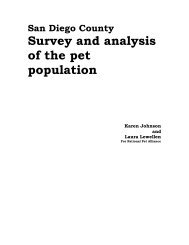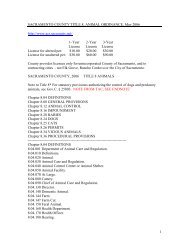Page 1 of 330 The Monthly National Legislation Report 7/5/2010 ...
Page 1 of 330 The Monthly National Legislation Report 7/5/2010 ...
Page 1 of 330 The Monthly National Legislation Report 7/5/2010 ...
Create successful ePaper yourself
Turn your PDF publications into a flip-book with our unique Google optimized e-Paper software.
<strong>The</strong> <strong>Monthly</strong> <strong>National</strong> <strong>Legislation</strong> <strong>Report</strong>http://mnlreport.typepad.com/<strong>Page</strong> 165 <strong>of</strong> <strong>330</strong>7/5/<strong>2010</strong>~~~~~~~~~~~~~~~~~~~~~~~~~~~~~~~~~~~~~~~~~~~~~~<strong>The</strong> United Organizations <strong>of</strong> the Horse Points Out the Problems Inherent in thePassage <strong>of</strong> the ROAM Act~~~~~~~~~~~~~~~~~~~~~~~~~~~~~~~~~~~~~~~~~~~~~~~~In a surprise move that was apparently designed to keep lawmakers in D.C. for voteson other critical issues, H.R. 1018 to amend the Wild Horse and Burro Act, passed theHouse on Friday, the 17th <strong>of</strong> July. Because <strong>of</strong> the sudden nature <strong>of</strong> this vote, theUnited Organizations <strong>of</strong> the Horse believes that many lawmakers cast their votewithout realizing the true ramifications <strong>of</strong> the legislation.<strong>The</strong> United Organizations <strong>of</strong> the Horse is a new organization that represents the horseowners <strong>of</strong> the United States based on a set <strong>of</strong> Core Principles that includes the propermanagement <strong>of</strong> wild horses. Central to this position is the idea that wild horsepopulations on public lands should be strictly controlled to ensure sustainable habitatfor horses, wildlife, and livestock. Included in the Core Principle on Wild Horses is thatthe recommendations <strong>of</strong> the Bureau <strong>of</strong> Land Management's (BLM) Wild Horse andBurro Advisory Committee should be implemented. Excess horses removed frompublic ranges should be disposed <strong>of</strong> either through sale or adoption. If the horsescannot be disposed <strong>of</strong> they should be humanely euthanized and processed and themeat and useful byproducts provided to the disadvantaged, or marketed and theproceeds reinvested in habitat enhancement and better management <strong>of</strong> wild herds.No wild horse should be held <strong>of</strong>f <strong>of</strong> public land at taxpayer expense for longer than 90days.<strong>The</strong> Government Accounting Office (GAO) has published a report that clearly indicatesthat the methodology used to count wild horses is flawed, and undercountspopulation. (Bureau <strong>of</strong> Land Management: Effective Long-Term Options Needed toManage Unadoptable Wild Horses-Oct. 9, 2008.) Actual experience in tragedies likeTrail Springs in Nevada, where hundreds <strong>of</strong> horses died from thirst and starvation in aHorse Management Area where the BLM methodology estimated around 300 horses,and when they gathered the area after the disaster was discovered, they gatheredover 1,100 animals not counting the ones that had already died. <strong>The</strong>se indications andthe fact that informal Google Earth photo counts indicate well over 100,000 wildhorses on public range that can sustainably carry 27,000, and which is alreadyoverstocked with the 36,000 that BLM's flawed methodology indicates are on the land.<strong>The</strong> ROAM Act exacerbates and intensifies the destruction <strong>of</strong> our public lands from toomany animals, and <strong>of</strong>fers no realistic solution to the problem. Without the ability tocontrol populations, BLM's hands are tied, and we are left with a $700 million dollarwelfare program for old horses at a time <strong>of</strong> dire circumstances in this Nation.<strong>The</strong> ROAM Act as passed by the House does not have a companion bill in the Senate,and it is our hope and intention to make sure that it does not progress. Included inseveral <strong>of</strong> it's provisions is the ability <strong>of</strong> the federal government to preempt any multiuse<strong>of</strong> government land to establish single species sanctuaries that would allow everywild horse to live out its 30+ years <strong>of</strong> natural life without any ability to control thepopulation.<strong>The</strong> United Organizations <strong>of</strong> the Horse will continue to work with other livestockorganizations, tribal governments, and public lands stakeholders to educate Senatorsand Congress on the pitfalls <strong>of</strong> this very dangerous piece <strong>of</strong> legislation.To learn more visit their website, http://www.UnitedOrgs<strong>of</strong>theHorse.org, andsubscribe to their free e-newsletter.~~~~~~~~~~~~~~~~~~~~~~~~~~~~~~~~~~~~~~~~~~~~~~~~Progress on the H.O.R.S.E. Act, and the Need for Constant Attention On-the-Ground inWashington, D.C.~~~~~~~~~~~~~~~~~~~~~~~~~~~~~~~~~~~~~~~~~~~~~~~~Things are progressing. We are still waiting for the bill language for the H.O.R.S.E. Actwhich is being drafted in Washington, D.C. We hope to have that to you soon. Pleasebe patient.<strong>The</strong> sudden and apparently fairly easy passage <strong>of</strong> the ROAM Act amendments to theWild Horse and Burro Act through the House is a clear indication <strong>of</strong> how desperatelywe need to gather the resources to have on-the-ground representation in Washington,D.C. on a constant basis to protect the interests <strong>of</strong> horse owners, and horse ownersrights. That is simply not possible now. We do not have the financial capability to




